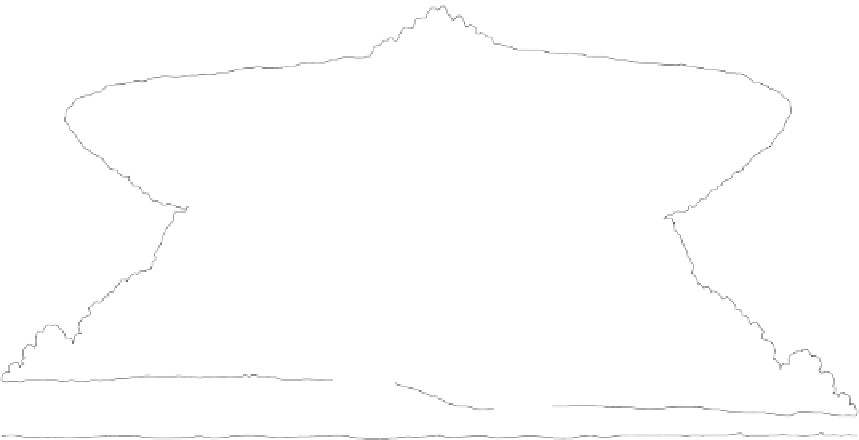Geoscience Reference
In-Depth Information
TURRET
Upper
negative
charge
Upper
positive
charge
(higher in updrafts)
-25°C
Main
negative
charge
-25°C
0°C
Lower
positive
charge
0°C
OUTSIDE
UPDRAFT
UPDRAFT
Figure 5.18
The electric charge structure in air mass storms in New Mexico, supercell storms and the convective
elements of mesoscale convective systems (see Chapter 9), based on balloon soundings of the electric field - 33 in
updrafts and 16 outside them. There are four vertical zones in the updraft region and six in the downdraft region, but
the size, strength and relative positions of the up- and downdrafts vary, as do the heights and temperatures shown.
Source: Stolzenburg et al. (1998) J. Geophys. Res.103, p.14,101, Fig. 3. Courtesy of the American Geophysical Union.
downdrafts of cold air. As these gather momen-
tum, cold air may eventually spread out below
the thunder cell in a wedge. Gradually, as the
moisture of the cell is expended, the supply of
released latent heat energy diminishes, the
downdrafts progressively gain in power over the
warm updrafts, and the cell dissipates.
To simplify the explanation, a thunderstorm
with only one cell was illustrated. Usually storms
are far more complex in structure and consist of
several cells arranged in clusters of 2-8km across,
100km or so in length and extending up to 10km
altitude or more. Such systems are known as squall
lines (see Chapter 9).
induction in the presence of an electric field, the
other is non-inductive charge transfer. The
ionosphere at 30-40km altitude is positively
charged (owing to the action of cosmic and solar
ultraviolet radiation in ionization) and the earth's
surface is negatively charged during fine weather.
Thus, cloud droplets can acquire an induced
positive charge on their lower side and negative
charge on their upper side. Non-inductive charge
transfer requires contact between cloud and
precipitation particles. According to J. Latham, the
major factor in cloud electrification is non-
inductive charge transfer involving collisions
between ice crystals growing by vapor diffusion
and warmer pellets of soft hail (graupel) growing
by riming. Recently, data from the TRMM satellite
mission have shown that such non-inductive
charging is the dominant mechanism for charge
separation in all regions of the globe. The accretion
of supercooled droplets (riming) on hail pellets
2 Cloud electrification and
lightning
Two general hypotheses help to account for
thunderstorm electrification. One involves































































































































































































































































































































